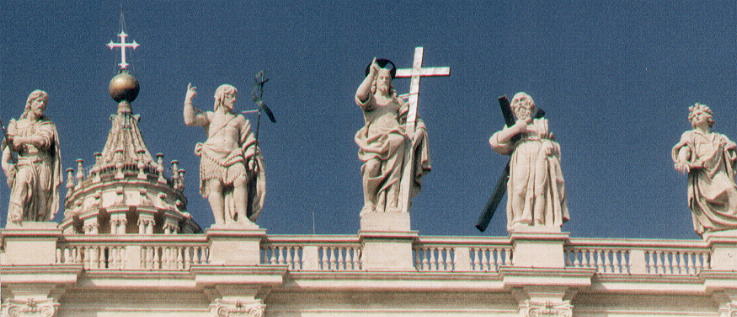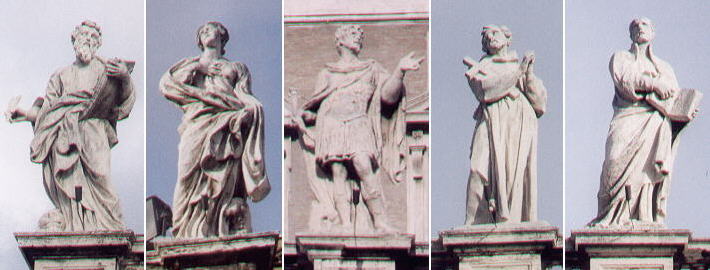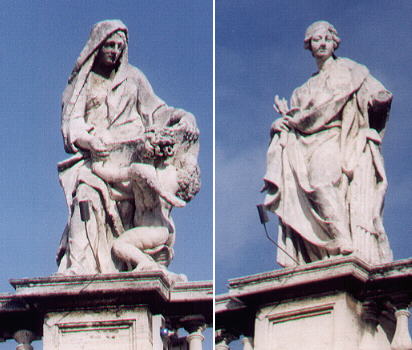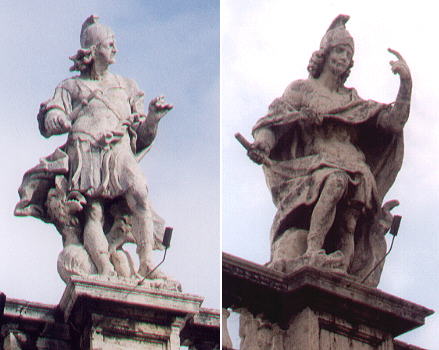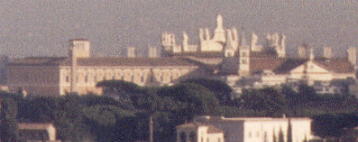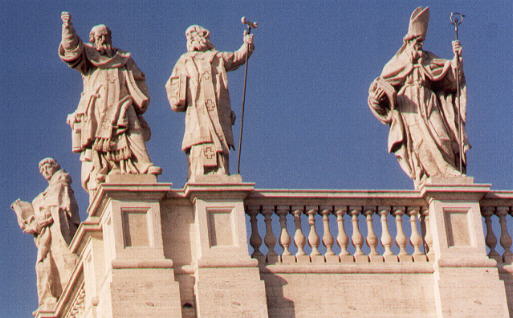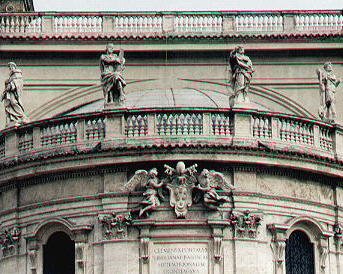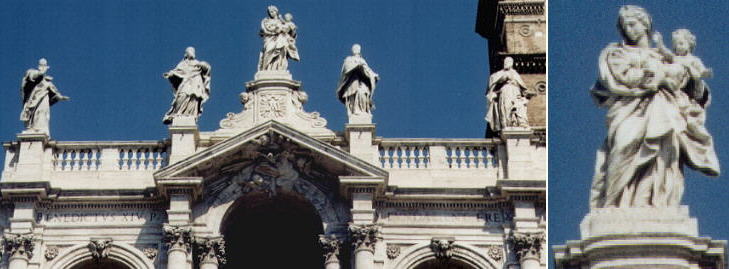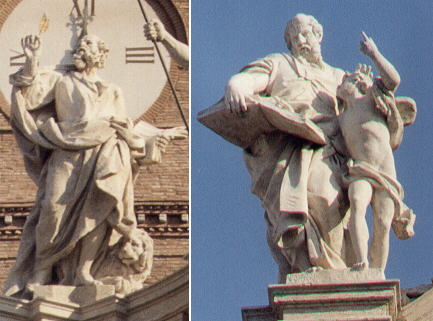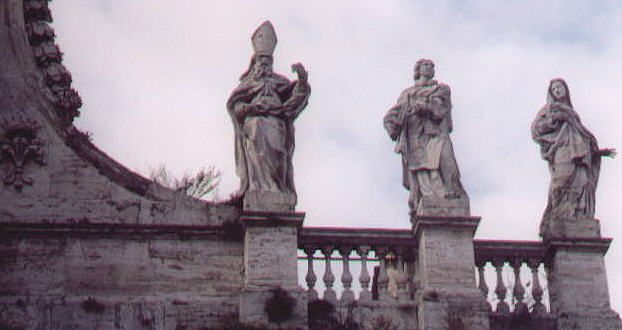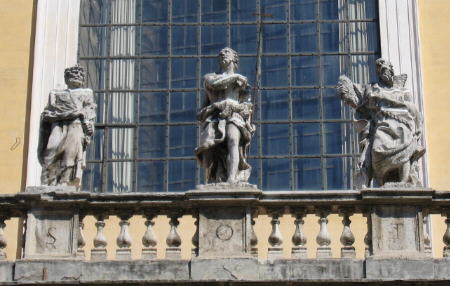  Statues Many statues in Rome are positioned at the top of churches and can only be seen at a great distance. The sculptors who were commissioned them were in general minor artists who accepted spending their time on a work which required a limited use of their skills. The statues were very often of a gigantic size (up to 20ft/6m) and in some cases their not visible side was left unfinished. The statues usually portrayed saints standing on their feet, but not in a rigid posture. Some details like dress embroideries were sculpted at a larger scale to make them more visible. S. Pietro Carlo Maderno designed for St Peter's
a façade which was very similar to a palace, because it lacked the central higher section, which usually characterizes the façade of churches. This
decision was due to the need of not hiding the view of the dome, a view which had already been impaired by the prolongation of the eastern
arm of the church originally designed by Michelangelo. The need to emphasize the religious nature of the façade and to increase
its verticality led to the decision of positioning 13 large statues on its top. The statues show Jesus with the Twelve Apostles, or to be
precise eleven apostles and St John Baptist. The missing apostle is St Peter, because he was portrayed (with St Paul) in a statue in the square
very near the façade.
Paulus V (1605-21) commissioned to Ambrogio Buonvicino from Milan the design of the statues, which were actually executed by other sculptors who were paid the same amount for each statue. In line with the traditional iconography the saints hold a reference to the way they were put to death: this helped their identification. The symbols of the martyrdom were cast in bronze to improve their visibility and for practical reasons: a device used in the past by Greeks and Romans and which was still evident in the reliefs of Colonna Traiana. In 1657 Gian Lorenzo Bernini completed the design of Piazza S. Pietro and he echoed the statues of the façade by positioning 90 statues of saints at the top the elliptical colonnades encircling a part of the square. The statues of the saints had the function of a choir and thus Bernini requested his assistants (Lazzaro Morelli, Giovanni Maria de' Rossi and a few others) who executed the statues to strictly conform to the same standard. The statues were smaller in size than the coats of arms of Pope Alexander VII (1655-67) which marked the center and the ends of the colonnades: so the statues seem to celebrate the glory of the pope. They were however intended to create the proper setting for the ceremonies of canonization by which new saints were created.
In the late XVIth century the Counter-Reformation had established formal processes for the canonization of new saints. On March 12, 1622 Pope Gregorius XV, in the course of a series of very spectacular ceremonies, created five new saints: the ceremonies took place in St Peter's, but also in other churches. Four of the five new saints were Spanish (S. Ignazio, S. Francesco Saverio, S. Teresa, S. Isidro) and one Italian (S. Filippo Neri). The creation of St Isidro in particular was a homage to the King of Spain as the new saint had been bishop of Madrid in 1130, when Madrid was a town of very little importance. Most of the cost of the ceremonies was borne by Spain. Pasquino, the most vocal talking statue of Rome criticized the event by saying: Oggi il papa ha canonizzato quattro spagnoli e un santo (today the pope canonized four Spanish and one saint). The successor of Gregorius XV, Urbanus VIII thought proper to review again the process of canonization. One of the outcomes of the review (completed in 1644) was to locate in St Peter's the ceremony of canonization and Alexander VII thought the new design of the square would provide the proper setting for this ceremony. In 1658 he inaugurated Piazza S. Pietro by canonizing a group of new saints (for the record: XVIIth century 24 new saints, XVIIIth century 29, XIXth century 78, XXth century 533) .
The selection of the saints must have been quite a headache: they were chosen to represent the different groups of saints: evangelists, martyrs, founders of religious orders. In the XVIIth century they were all identifiable even by the least cultured people, because their lives were the subject of popular tales and innumerable paintings. But there is no perfect Who's who and in 1703 Clemens XI added another 50 saints to the first group.
The new statues were positioned at the top of the series of pillars which link the colonnade with the façade. The sculptors had to comply with the standards of size defined by Bernini for the colonnade, but they took some freedom (some of them were among the best sculptors of that period). Jean-Baptiste Théudon was allowed to add an angel to S. Francesca Romana and make a little group. The choice of the new saints responded to some criticism concerning the first selection: the statues of S. Francesca Romana and S. Cecilia (again by Jean-Baptiste Théudon) met the requests of the Roman common people who had a special devotion for these two saints.
The positioning of the statues, like the seating of the guests at a formal dinner, was not haphazard: sometimes saints having something in common were grouped together (the founders of the orders, the popes, S. Francesca Romana and S. Cecilia, etc..), in other cases they were located in the opposite sides of the square. The statues of S. Giorgio (by Lorenzo Ottoni) and S. Crescentino (by Jean-Baptiste Théudon), saints who both fought against a dragon are the third statue on the right and left side of the square between the colonnade and the façade. See also: St Peter's: it wasn't done in a day! S. Giovanni in Laterano
After the renovation of the interior of S. Giovanni in Laterano, done by Francesco Borromini in the 1650s,
the old portico façade did not match any longer with the new size of the naves and of the chapels.
In 1732 Alessandro Galilei, a Florentine architect who had worked for five years in England, won the contest for the design of the new façade. The façade
he eventually built had several points in common with the façade of St Peter's, the most evident one being the gigantic statues of Jesus
and the Doctors of the Church on its top.
The choice of portraying the Doctors of the Church, although justified by religious considerations, limited the appeal of the statues
because most of the saints were not associated with well known miracles or events. Minor sculptors were involved in the execution
of the statues, the best sculptors being busy at the time with the decoration of the Corsini chapel inside the basilica or of
Fontana di Trevi.
The new pope Clemens X felt that the project was too expensive and he requested of Carlo Rainaldi a new simpler design which was completed in 1675. Only four statues were put on the top of the balustrade. In 1741 Pope Benedictus XIV decided to renovate the main façade of S. Maria Maggiore. The architect, Ferdinando Fuga, designed a large loggia which preserved part of the original façade with its XIIIth century mosaics. The loggia was surmounted by a statue of the Virgin Mary, attributed to Bernardino Ludovisi.
The statue of the Virgin Mary is accompanied by the statues of four popes who promoted major renovations of the basilica. S. Croce in Gerusalemme
Benedictus XIV (1740-58) renovated the interior of the church and added an oval vestibule designed by Domenico Gregorini and Pietro Passalacqua
which covers the old façade. The church is dedicated to St Helena, mother of Constantine and they both are celebrated by a statue on the
top of the façade. Four other statues are dedicated to the Evangelists.
Other churches The use of large statues on the top of churches was not limited to the basilicas and it was adopted by Baroque architects also in many other churches. Carlo Rainaldi, who designed the churches of S. Maria dei Miracoli and S. Maria in Montesanto under the supervision of Gian Lorenzo Bernini, positioned several statues around the domes of the churches. Alessandro Galilei, in addition to the façade of S. Giovanni in Laterano, designed that of S. Giovanni dei Fiorentini: in this case the choice of the saints responded to architectural needs.
Other churches surmounted with statues of saints are: SS. Apostoli, S. Silvestro in Capite, SS. Nome di Maria, S. Marcello, S. Francesca Romana, S. Maria della Consolazione.
Other pages dealing with Baroque sculpture: Statues in the act of praying Representation of Death in Baroque sculptures Monuments showing the dead in a medallion Baroque Angels Three chapels by Gian Lorenzo Bernini Three busts by Alessandro Algardi Baroque High Reliefs Baroque Monuments to the Popes Embittered Andrew (the statues in St. Peter's octagon) Laughing Masks Playing with Colours See also my List of Baroque Architects and my Directory of Baroque Sculpture. 
Go to my Home Page on Baroque Rome or to my Home Page on Rome in the footsteps of an XVIIIth century traveller. |
All images © 1999 - 2003 by Roberto Piperno. Write to romapip@quipo.it
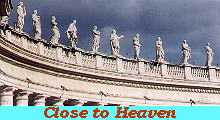 Introduction
Introduction